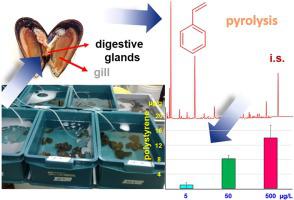当前位置:
X-MOL 学术
›
J. Anal. Appl. Pyrol.
›
论文详情
Our official English website, www.x-mol.net, welcomes your
feedback! (Note: you will need to create a separate account there.)
Off-line analytical pyrolysis GC-MS to study the accumulation of polystyrene microparticles in exposed mussels
Journal of Analytical and Applied Pyrolysis ( IF 5.8 ) Pub Date : 2020-08-01 , DOI: 10.1016/j.jaap.2020.104836 Daniele Fabbri , Alessandro G. Rombolà , Ivano Vassura , Cristian Torri , Silvia Franzellitti , Marco Capolupo , Elena Fabbri
Journal of Analytical and Applied Pyrolysis ( IF 5.8 ) Pub Date : 2020-08-01 , DOI: 10.1016/j.jaap.2020.104836 Daniele Fabbri , Alessandro G. Rombolà , Ivano Vassura , Cristian Torri , Silvia Franzellitti , Marco Capolupo , Elena Fabbri

|
Abstract An analytical procedure based on off-line analytical pyrolysis was utilized to study the bioaccumulation of polystyrene microspheres with different size (3 μm and 45 μm) by gills and digestive glands of Mytilus galloprovincialis exposed for 4 days at different concentrations of the polymer (3 μm: 0.015–1.5 μg L−1; 45 μm: 5−500 μg L−1). The mussel tissues were treated with 10 % KOH at 90 °C with good digestion efficiency (97 ± 1 %) and extracted with toluene. After evaporation the residue was pyrolysed at 500 °C with a resistively heated platinum filament. Pyrolysis products were trapped onto a charcoal cartridge, eluted with toluene and analysed by GC–MS under selected ion monitoring. Polystyrene concentrations were determined by the internal standard method from the peak areas of styrene. The procedure provided information on the effect of particle size, exposure level and tissue type on the bioaccumulation of polystyrene particles in terms of mass concentrations. Accumulation was observed in digestive glands, not in gills. The accumulation of larger particles in digestive glands increased with increasing concentrations of polystyrene in water and peaked at 14 ± 4 μg g−1. The reduction of lysosome membrane stability was observed for both particles size at a water concentration of 10,000 particles per litre, that corresponded to a lower mass concentration for the smaller particles. This study confirmed the capability of analytical pyrolysis to provide microplastic concentrations in terms of mass concentration in complex matrices.
中文翻译:

离线分析热解 GC-MS 研究暴露贻贝中聚苯乙烯微粒的积累
摘要 利用基于离线分析热解的分析程序,研究了在不同浓度的聚合物 (3) 下暴露 4 天的 Mytilus galloprovincialis 鳃和消化腺对不同尺寸 (3 μm 和 45 μm) 聚苯乙烯微球的生物积累。 μm:0.015–1.5 μg L-1;45 μm:5-500 μg L-1)。贻贝组织在 90 °C 下用 10% KOH 处理,消化效率良好 (97 ± 1%),并用甲苯提取。蒸发后,残余物用电阻加热的铂丝在 500°C 下热解。热解产物被困在木炭柱上,用甲苯洗脱,并在选择离子监测下通过 GC-MS 进行分析。聚苯乙烯浓度通过内标法从苯乙烯的峰面积确定。该程序提供了有关颗粒大小、暴露水平和组织类型对聚苯乙烯颗粒在质量浓度方面的生物积累的影响的信息。在消化腺中观察到积累,而不是在鳃中。消化腺中较大颗粒的积累随着水中聚苯乙烯浓度的增加而增加,峰值为 14 ± 4 μg g-1。在每升 10,000 个颗粒的水浓度下,两种颗粒大小都观察到溶酶体膜稳定性的降低,这对应于较小颗粒的较低质量浓度。该研究证实了分析热解能够以复杂基质中的质量浓度提供微塑料浓度。暴露水平和组织类型对聚苯乙烯颗粒生物累积的质量浓度。在消化腺中观察到积累,而不是在鳃中。消化腺中较大颗粒的积累随着水中聚苯乙烯浓度的增加而增加,峰值为 14 ± 4 μg g-1。在每升 10,000 个颗粒的水浓度下,两种颗粒大小都观察到溶酶体膜稳定性的降低,这对应于较小颗粒的较低质量浓度。该研究证实了分析热解能够以复杂基质中的质量浓度提供微塑料浓度。暴露水平和组织类型对聚苯乙烯颗粒生物累积的质量浓度。在消化腺中观察到积累,而不是在鳃中。消化腺中较大颗粒的积累随着水中聚苯乙烯浓度的增加而增加,峰值为 14 ± 4 μg g-1。在每升 10,000 个颗粒的水浓度下,两种颗粒大小都观察到溶酶体膜稳定性的降低,这对应于较小颗粒的较低质量浓度。该研究证实了分析热解能够以复杂基质中的质量浓度提供微塑料浓度。消化腺中较大颗粒的积累随着水中聚苯乙烯浓度的增加而增加,峰值为 14 ± 4 μg g-1。在每升 10,000 个颗粒的水浓度下,两种颗粒大小都观察到溶酶体膜稳定性的降低,这对应于较小颗粒的较低质量浓度。该研究证实了分析热解能够以复杂基质中的质量浓度提供微塑料浓度。消化腺中较大颗粒的积累随着水中聚苯乙烯浓度的增加而增加,峰值为 14 ± 4 μg g-1。在每升 10,000 个颗粒的水浓度下,两种颗粒大小都观察到溶酶体膜稳定性的降低,这对应于较小颗粒的较低质量浓度。该研究证实了分析热解能够以复杂基质中的质量浓度提供微塑料浓度。
更新日期:2020-08-01
中文翻译:

离线分析热解 GC-MS 研究暴露贻贝中聚苯乙烯微粒的积累
摘要 利用基于离线分析热解的分析程序,研究了在不同浓度的聚合物 (3) 下暴露 4 天的 Mytilus galloprovincialis 鳃和消化腺对不同尺寸 (3 μm 和 45 μm) 聚苯乙烯微球的生物积累。 μm:0.015–1.5 μg L-1;45 μm:5-500 μg L-1)。贻贝组织在 90 °C 下用 10% KOH 处理,消化效率良好 (97 ± 1%),并用甲苯提取。蒸发后,残余物用电阻加热的铂丝在 500°C 下热解。热解产物被困在木炭柱上,用甲苯洗脱,并在选择离子监测下通过 GC-MS 进行分析。聚苯乙烯浓度通过内标法从苯乙烯的峰面积确定。该程序提供了有关颗粒大小、暴露水平和组织类型对聚苯乙烯颗粒在质量浓度方面的生物积累的影响的信息。在消化腺中观察到积累,而不是在鳃中。消化腺中较大颗粒的积累随着水中聚苯乙烯浓度的增加而增加,峰值为 14 ± 4 μg g-1。在每升 10,000 个颗粒的水浓度下,两种颗粒大小都观察到溶酶体膜稳定性的降低,这对应于较小颗粒的较低质量浓度。该研究证实了分析热解能够以复杂基质中的质量浓度提供微塑料浓度。暴露水平和组织类型对聚苯乙烯颗粒生物累积的质量浓度。在消化腺中观察到积累,而不是在鳃中。消化腺中较大颗粒的积累随着水中聚苯乙烯浓度的增加而增加,峰值为 14 ± 4 μg g-1。在每升 10,000 个颗粒的水浓度下,两种颗粒大小都观察到溶酶体膜稳定性的降低,这对应于较小颗粒的较低质量浓度。该研究证实了分析热解能够以复杂基质中的质量浓度提供微塑料浓度。暴露水平和组织类型对聚苯乙烯颗粒生物累积的质量浓度。在消化腺中观察到积累,而不是在鳃中。消化腺中较大颗粒的积累随着水中聚苯乙烯浓度的增加而增加,峰值为 14 ± 4 μg g-1。在每升 10,000 个颗粒的水浓度下,两种颗粒大小都观察到溶酶体膜稳定性的降低,这对应于较小颗粒的较低质量浓度。该研究证实了分析热解能够以复杂基质中的质量浓度提供微塑料浓度。消化腺中较大颗粒的积累随着水中聚苯乙烯浓度的增加而增加,峰值为 14 ± 4 μg g-1。在每升 10,000 个颗粒的水浓度下,两种颗粒大小都观察到溶酶体膜稳定性的降低,这对应于较小颗粒的较低质量浓度。该研究证实了分析热解能够以复杂基质中的质量浓度提供微塑料浓度。消化腺中较大颗粒的积累随着水中聚苯乙烯浓度的增加而增加,峰值为 14 ± 4 μg g-1。在每升 10,000 个颗粒的水浓度下,两种颗粒大小都观察到溶酶体膜稳定性的降低,这对应于较小颗粒的较低质量浓度。该研究证实了分析热解能够以复杂基质中的质量浓度提供微塑料浓度。











































 京公网安备 11010802027423号
京公网安备 11010802027423号